Another Saturday, and another opportunity to spend several
hours on the Big Twin, after an early morning 2 hour paddle
in the Larsboat
on the near-by Meramec River.
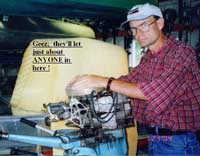 (click images to enlarge)
(click images to enlarge) |
The first thing that I did was to remove the magneto that
I had previously re-mounted; not due to any problems, but
because I had decided to make the installation of a lanyard
equiped safety shut-down switch the subject of a future column,
and the Big Twin would serve as a guinea pig for that. So
the magneto was removed and some alterations made and a few
photos taken and then it was remounted.
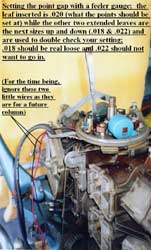 One may have noted that in the previous part of this column,
I made no mention of setting the "gap" on the ignition
points before testing for a spark; this was not an omission
in my writing. I just forgot to adjust them. That the ignition
system would still produce a spark is a testament to it's
reliability. After reinstalling the magneto today, I did remember
to adjust the point gap to .020, using a cheap feeler gauge
and a regular screwdriver which are the only tools required.
One may have noted that in the previous part of this column,
I made no mention of setting the "gap" on the ignition
points before testing for a spark; this was not an omission
in my writing. I just forgot to adjust them. That the ignition
system would still produce a spark is a testament to it's
reliability. After reinstalling the magneto today, I did remember
to adjust the point gap to .020, using a cheap feeler gauge
and a regular screwdriver which are the only tools required.
The flywheel was then installed and torqued and the recoil
starter remounted.
I make it a habit to always replace the fuel hoses on any
engine that I am "refurbishing," and the Big Twin
was no exception. The only hoses on this - pressure-tank-utilizing
engine are the hose which conducts the pressure from the crankcase
to the "quick connect" fitting, and the hose from
the quick connect fitting to the carburetor which carries
the fuel. Although this engine had a fuel strainer incorporated
into the carburetor, I added a small "in-line: fuel filter
as well, which is my habit.
 Finally,
the adjustment synchronizing the ignition advance to the carburetor
throttle valve was made. On most of these old OMC's this is
no more complicated than loosening a tapered "cam"
and moving it back and forth until the throttle valve begins
to open when the valve's "follower," which rides
on the cam, reaches a certain mark on the cam. No "diagnostic"
computer needed.
Finally,
the adjustment synchronizing the ignition advance to the carburetor
throttle valve was made. On most of these old OMC's this is
no more complicated than loosening a tapered "cam"
and moving it back and forth until the throttle valve begins
to open when the valve's "follower," which rides
on the cam, reaches a certain mark on the cam. No "diagnostic"
computer needed.
What WAS now needed was a solid mounting surface in order
to attempt to start the Big Twin, and the AF4
provided that; the Big Twin was clamped to the transom with
it's "leg" submerged in water in the plastic 55-gallon
drum that serves as my outboard motor :"test tank."
The low- and high-speed mixture adjusting needles were set
at about 1 full turn open (not the correct setting it turns
out) and I commenced to "yanking" on the starter
rope of this manual-start-only engine.
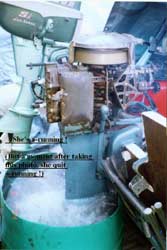 After
a few pulls, the thing actually started, coughing and wheezing
as it blew smoke and water in large quantities; some fiddling
with the mixture controls settled it down a bit, and I left
it running at a fast idle while I took a few photos. Then
the thing coughed on last time and quit. I cranked it over
several times, then several times more, and then some more,
but it would not start.
After
a few pulls, the thing actually started, coughing and wheezing
as it blew smoke and water in large quantities; some fiddling
with the mixture controls settled it down a bit, and I left
it running at a fast idle while I took a few photos. Then
the thing coughed on last time and quit. I cranked it over
several times, then several times more, and then some more,
but it would not start.
I made some adjustments to the mixture needles and pulled
the rope some more and it still would not start.
A few more adjustments, then some tries with the choke off,
then with the choke on, then with the mixture needles screwed-down
shut (in case it was flooded) but nothing would coax the engine
to fire-off.
It is at this point in the process that people tend to become
irrational and end-up yanking the starter rope until they
are blue in the face, or end up grinding away at the electric
start until the battery is dead, or until the starter motor
overheats so bad that it throws it's solder all over itself
and self-destructs.
After about 10 minutes of attempting to start an engine that
had been running just moments before, I decided it was time
for some trouble-shooting. since numerous adjustments had
already been made to the carb with nary a hint of an intention
to run again, I decided to check to see if the magneto was
still working. Removing the spark plugs and grounding them
to the engine block revealed no spark when the engine was
cranked. The recoil starter was removed and the flywheel slowly
rotated by hand, revealing a slight"clicking" or
snapping noise. Could be a spark jumping to a "ground,"
or could be something hitting the flywheel. Since I was careful
to check for any interference with the flywheel when I mounted
the magneto, I could not believe that there was a problem
now, but I drug out the flywheel puller anyway and removed
the flywheel.
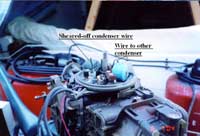 As
I lifted the flywheel off, I immediately noticed that one
of the condenser' wires was broken off; evidently the flywheel
magnet caught it and ripped it apart. That would prevent one
cylinder from sparking, and while a properly turned 2-cycle,
2-cylinder engine will often run on one live cylinder, the
Big Twin had only been running for a minute or two and was
far from being "in tune."
As
I lifted the flywheel off, I immediately noticed that one
of the condenser' wires was broken off; evidently the flywheel
magnet caught it and ripped it apart. That would prevent one
cylinder from sparking, and while a properly turned 2-cycle,
2-cylinder engine will often run on one live cylinder, the
Big Twin had only been running for a minute or two and was
far from being "in tune."
I replaced the damaged condenser with one from my stock, and
also rechecked the point gap setting (as one should always
do whenever the magneto is disturbed,) and "buttoned-up"
the engine again, making darn sure that the wires underneath
the flywheel were routed well clear of rotating parts.
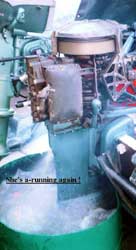 A
few more pulls on the starter rope and the engine fired-up
again. A few minutes of running showed that the engine was
most likely ambitious-enough to keep running for a while.
It also was pumping cooling water well, although after several
minutes the discharge water began to heat-up to the point
that it was almost too hot to keep one's hand in the stream.
An outboard run in a bucket can overheat very easily, however,
so while it is an item to check carefully during the engine's
first run on a boat, at this point I will not consider it
a problem.
A
few more pulls on the starter rope and the engine fired-up
again. A few minutes of running showed that the engine was
most likely ambitious-enough to keep running for a while.
It also was pumping cooling water well, although after several
minutes the discharge water began to heat-up to the point
that it was almost too hot to keep one's hand in the stream.
An outboard run in a bucket can overheat very easily, however,
so while it is an item to check carefully during the engine's
first run on a boat, at this point I will not consider it
a problem.
Tomorrow I will haul the AF4
and Big Twin down to the launch ramp on the Meramec River,
where the park gates are unlocked at 7:00 am but the gentleman
who collects the ramp fee does not arrive at work until 8:00,
leaving me with a one-hour "window of opportunity"
for a free launch.
On to Part
4

